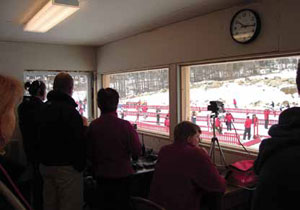Audio Slalom

Black Mountain Expels Wires for IP, Improves Audio and Data Paths
The Barix Exstreamer provides sound that reaches spectators gathered on the deck of the lodge, and on the bridge crossing over the Nordic racecourse.
RUMFORD, ME—Black Mountain of Maine doubles as a family-oriented Alpine and Nordic ski area and home of the Chisholm Ski Club. The ski club supports competitive skiing and hosts a variety of local, state, regional, and national races and events.
The club and the facility recently were awarded the USSA U.S. Cross Country Ski Championships for 2011 and 2012. New International Ski Federation (FI S) rules required improvements for courses and startfinish areas and influenced the ski club to make changes to the stadium area, including the public address system that connects the Nordic competition stadium to the main lodge.
Ski areas are notoriously difficult places to install and maintain cabling infrastructure. The expense of running cable over long distances adds to the headaches. Naturally, the ability to carry more signals over fewer wires is preferable. Sometimes, wires aren’t the answer at all.
Black Mountain previously used a wireless microphone system with two receivers to link audio between the stadium and the main lodge. The data network was comprised of a point-to-point 802.11B/G wireless link fed by two short runs of Cat-5e between two building locations. Although reasonably effective, the upgrade to a wireless mesh network—with assistance from a Barix Audio over IP solution— would provide massive improvements for distributing audio and data to several points.
“We need to communicate clearly with everyone on the trails, around the stadium and the lodge,” said Craig Zurhorst, a Chisholm Ski Club volunteer and the club’s audiovisual system coordinator. “It’s important to communicate when the course is closed to general traffic, information about coach’s meetings, and updates to start times—all very critical to running a race well.”
A daily selection of the top stories for AV integrators, resellers and consultants. Sign up below.
Zurhorst and fellow volunteer Bob Arsenault, the club’s timing and scoring lead and IT manager, worked with Anaptyx Wireless Dynamics to implement the wireless mesh network. The Boston-area company provided an affordable radio system utilizing 900MHz network transport along with 802B, G and N client communications. The lowerfrequency network backbone made the trees and other non-metallic obstructions a non-issue.
The Anaptyx OD2N-900MHz system provides redundant-path data transport between buildings and WiFi service throughout the stadium area. The data network terminates at the ski lodge, supporting distribution of scoring information for projection. The system also supports audio over IP to deliver sound to the lodge.
In the stadium, a RadioShack mixer collects audio from a Sennheiser Evo-100 G3 handheld microphone, a new Behringer dynamic microphone, a CD player, and an MP3 player. An Optimus MPA-250 amplifier powers a Bogen NE AR A12 weatherproof 16-ohm loudspeaker. The natural amphitheater, formed by a ledge and the adjoining mountain slope, assists the single loudspeaker in sufficiently covering the entire football-sized stadium and nearby parking lot with crystal-clear audio.
Zurhorst opted for Barix Audio over IP equipment to pass lowlatency audio to other points over the network. A Barix Instreamer 100 encodes the same audio stream at the source and passes it over the mesh network to an Exstreamer 100 for decoding.
The Exstreamer provides the signal to a Lectrosonics DM812 digital automated matrix mixer, which feeds an Electro-Voice PA2250T amplifier powering two Bogen NE AR A8T speakers outside the lodge and four NE AR A2T speakers inside. The signal is also sent to a TOA BG-130 utility amplifier to power hall and restroom speakers inside the lodge.
Zurhorst noted that the Exstreamer provides very lowlatency audio that is every bit as clear as the stadium sound. The sound reaches spectators gathered on the deck of the lodge, and on the bridge crossing over the Nordic racecourse from the lodge deck to the apron of the Alpine ski area.
“Barix is known for its broadcast equipment as well as its IP -based institutional sound distribution systems,” said Zurhorst. “When we decided to integrate everything on a wireless IP network, I knew Barix would have the ideal solution.”
